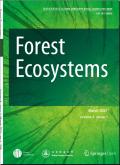落叶林中木质层复杂性对节肢动物生物量和丰度的环境依赖效应
IF 4.4
1区 农林科学
Q1 FORESTRY
引用次数: 0
摘要
森林结构复杂性影响节肢动物群落通过塑造栖息地的可用性,小气候条件和资源分布。然而,在温带森林中,结构复杂性和特定结构成分驱动节肢动物丰度和生物量的程度仍然知之甚少。本研究考察了比利时19个温带落叶森林(以有花序栎树、欧洲山毛榉和加拿大杨树为主)的本地和景观尺度森林特征对垂直地层(森林地面(FF)、草本层和灌木层(SL))节肢动物群落的影响。在局地尺度上,我们评估了优势树种特征、整体森林结构复杂性及其组成(垂直和水平结构、木本层、草本层和枯木)。在景观尺度上,我们评估了森林面积、边缘长度、森林覆盖和植被绿化率(归一化植被指数NDVI)。与预期相反,节肢动物生物量和丰度并没有随着结构复杂性的增加而增加。相反,木本层复杂性、优势树种和NDVI成为关键驱动因素,其影响因环境和地层而异。节肢动物的丰度和生物量在栎树和杨树林中最高,在山毛榉林中最低,这可能是由于凋落物质量、微生境可利用性和林下发育的差异。木本层复杂性对地面节肢动物有正向影响,而对栎林有负向影响。在景观尺度上,NDVI出乎意料地与各层节肢动物丰度和草本层节肢动物生物量呈负相关,这可能反映了茂密的林冠对林下生产力的抑制。森林地面节肢动物生物量随森林覆盖的增加而增加,灌木层节肢动物丰度随森林覆盖的增加而减少,但随森林面积的增加而增加。这些发现强调了森林结构属性、优势树种和景观因素在节肢动物群落形成中的复杂相互作用。通过确定节肢动物丰度和生物量的关键驱动因素,本研究有助于更好地理解温带森林生物多样性格局及其生态动态。本文章由计算机程序翻译,如有差异,请以英文原文为准。
Context-dependent effects of woody layer complexity on arthropod biomass and abundance in deciduous forests
Forest structural complexity influences arthropod communities by shaping habitat availability, microclimatic conditions, and resource distribution. However, the extent to which structural complexity and specific structural components drive arthropod abundance and biomass remains poorly understood in temperate forests. This study examined how local and landscape-scale forest characteristics influence arthropod communities across vertical strata (forest floor (FF), herb layer (HL), and shrub layer (SL)) in 19 temperate deciduous forests in Belgium, dominated by pedunculate oak, European beech, or Canadian poplar. At the local scale, we assessed dominant tree species identity, overall forest structural complexity, and its components (vertical and horizontal structure, woody layer, herbal layer, and deadwood). At the landscape scale, we evaluated forest area, edge length, forest cover, and vegetation greenness (normalized difference vegetation index (NDVI)). Contrary to expectation, arthropod biomass and abundance did not consistently increase with higher structural complexity. Instead, woody layer complexity, dominant tree species, and NDVI emerged as key drivers, with effects varying by context and stratum. Arthropod abundance and biomass were the highest in oak- and poplar-dominated forests and the lowest in beech forests, likely due to differences in litter quality, microhabitat availability, and understory development. Woody layer complexity positively influenced forest floor arthropods in poplar forests but had a negative effect in oak forests. At the landscape scale, NDVI unexpectedly showed negative relationships with arthropod abundance across strata and with arthropod biomass in the herb layer, likely reflecting dense canopy suppression of understory productivity. Arthropod biomass on the forest floor increased with forest cover, while abundance in the shrub layer decreased with forest cover but increased with forest area. These findings highlight the complex interplay between forest structural attributes, dominant tree species, and landscape factors in shaping arthropod communities. By identifying the key drivers of arthropod abundance and biomass, this study contributes to a better understanding of biodiversity patterns in temperate forests and their ecological dynamics.
求助全文
通过发布文献求助,成功后即可免费获取论文全文。
去求助
来源期刊

Forest Ecosystems
Environmental Science-Nature and Landscape Conservation
CiteScore
7.10
自引率
4.90%
发文量
1115
审稿时长
22 days
期刊介绍:
Forest Ecosystems is an open access, peer-reviewed journal publishing scientific communications from any discipline that can provide interesting contributions about the structure and dynamics of "natural" and "domesticated" forest ecosystems, and their services to people. The journal welcomes innovative science as well as application oriented work that will enhance understanding of woody plant communities. Very specific studies are welcome if they are part of a thematic series that provides some holistic perspective that is of general interest.
 求助内容:
求助内容: 应助结果提醒方式:
应助结果提醒方式:


